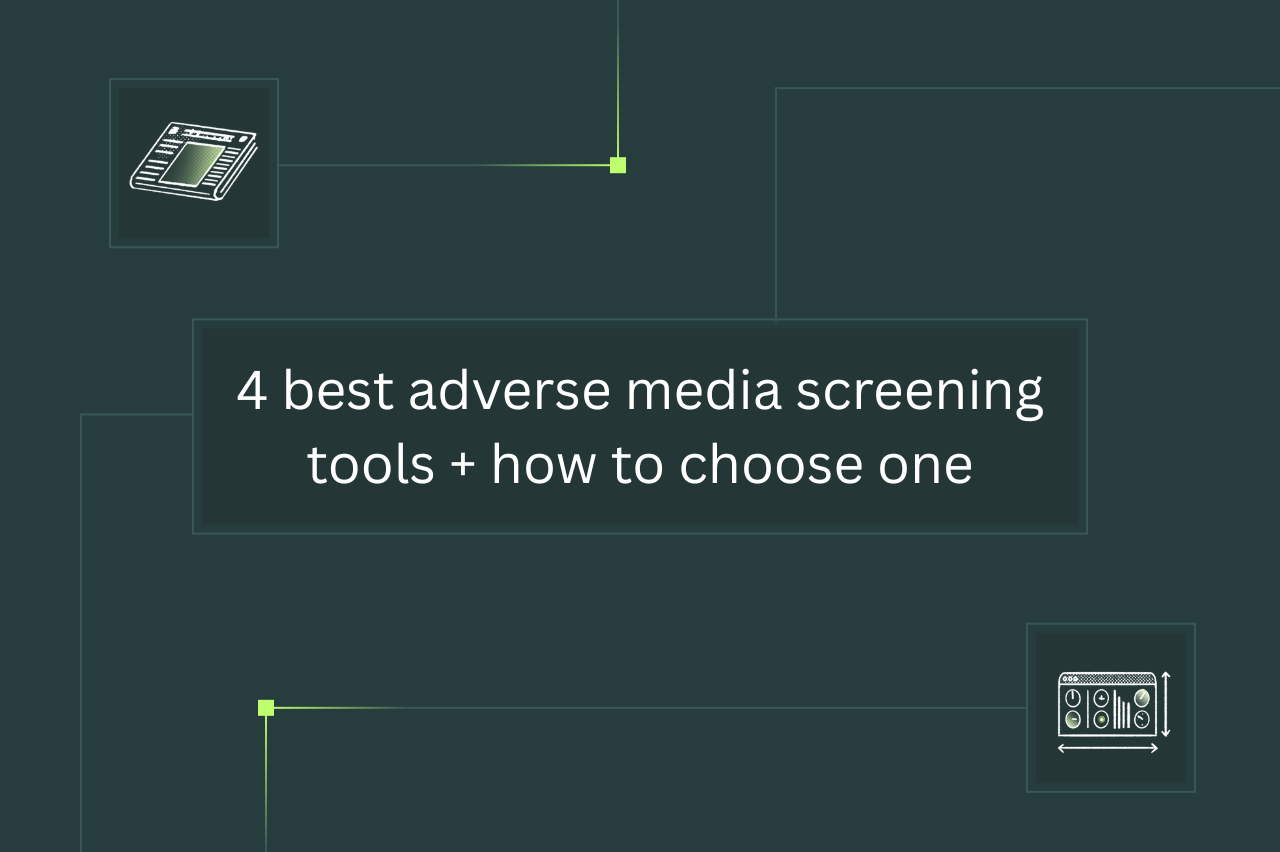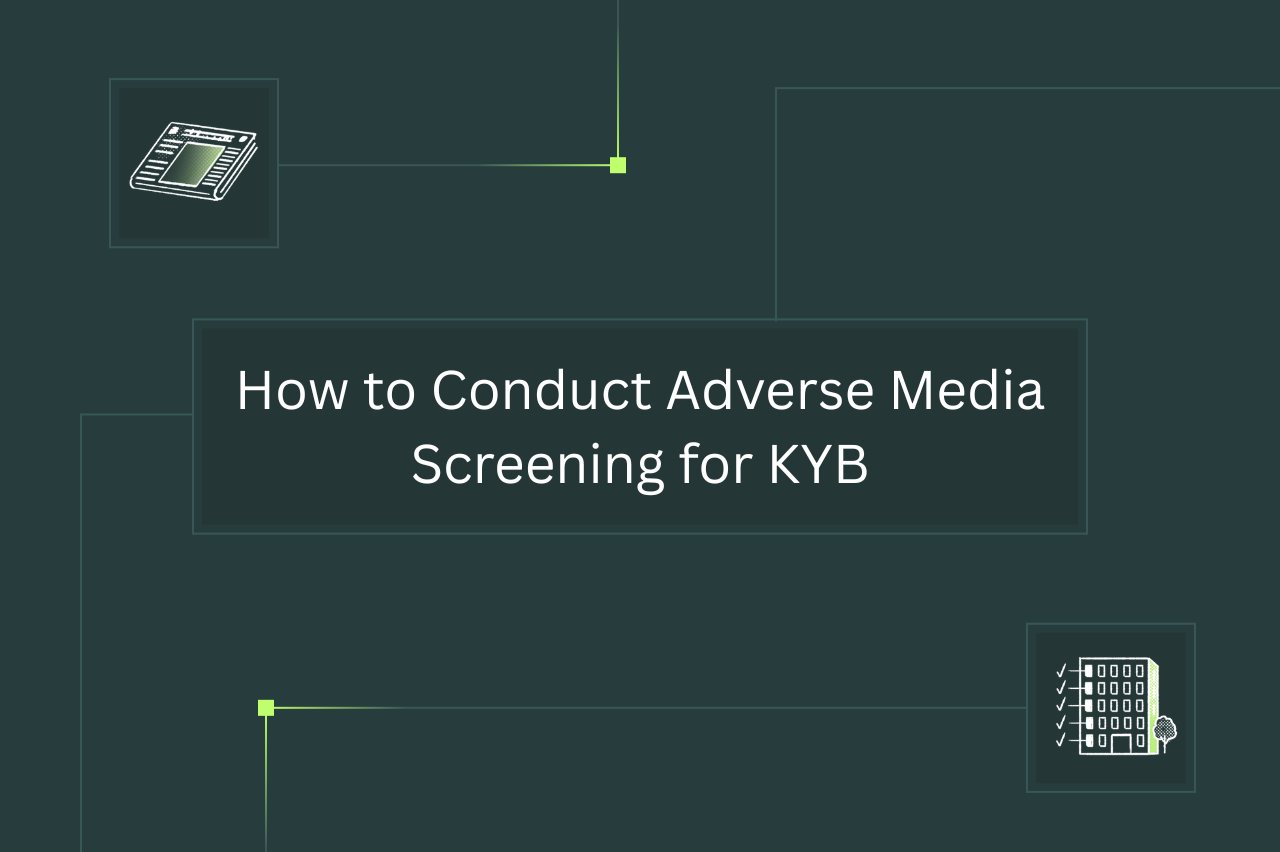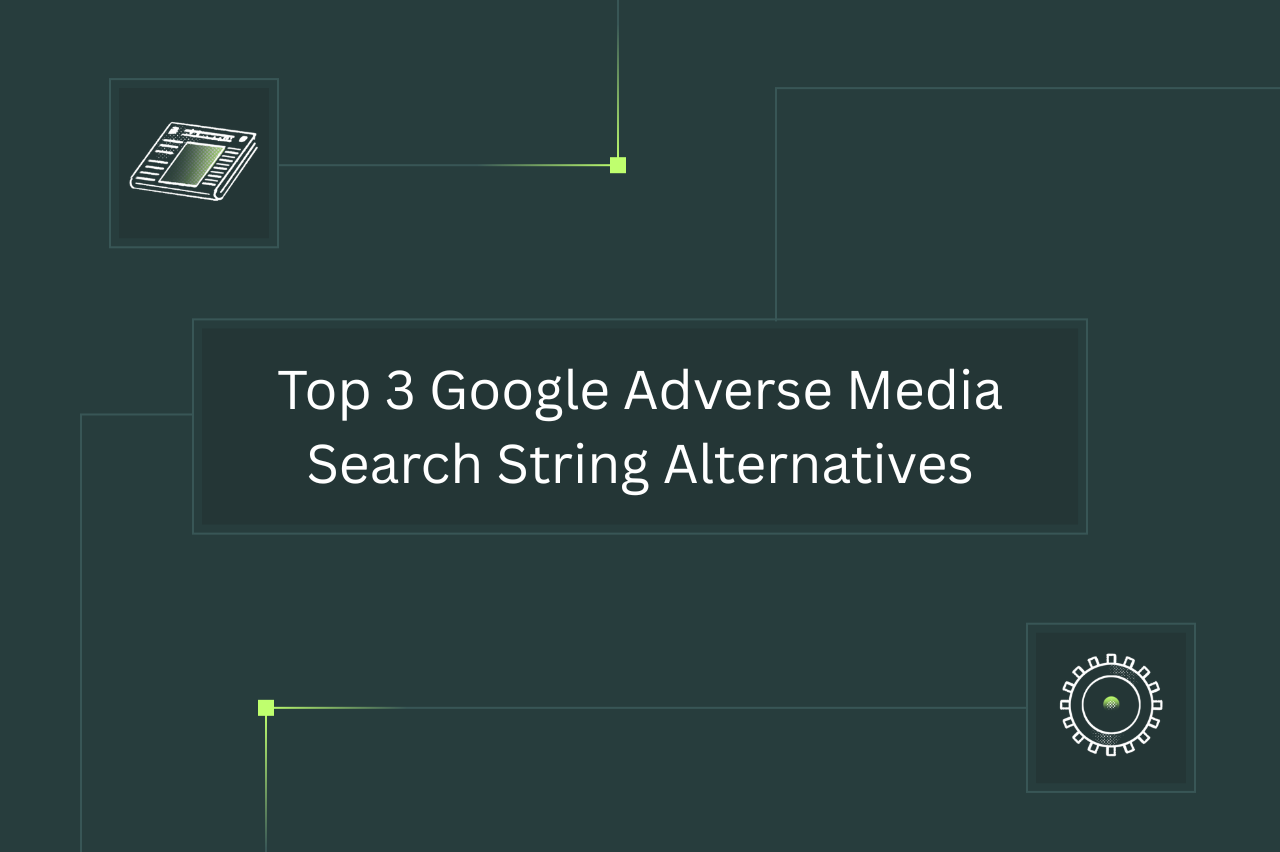In brief:
- Adverse media screening tools are software programs or functions that search public media sources for risk-signaling information about businesses or associated entities.
- Though adverse media screening has become a mandatory KYB process in many places, it still presents challenges related to the volume and credibility of sources, as well as name and context matching.
- Desirable features for adverse media screening software include natural language processing, risk categorization, entity case management, and continuous monitoring capabilities.
Part of assessing the risk in a business-to-business relationship is checking to make sure the other business’ official information is registered, valid, and correct. Another part of it is looking for risk signals regarding what the other business has done or is doing. To this end, a due diligence process that is becoming increasingly important is adverse media screening.
Adverse media screening involves checking public information for negative coverage of a business, person, or other entity. However, what counts as “adverse media” is rather unspecific, leading to potentially thousands of different sources to search. Some cannot be freely accessed, while others do not have credible information. In addition, the information itself may not be relevant based on the context of certain words and names.
Many businesses are trying to solve these issues by using adverse media screening tools. This article discusses what those are and how to get the most out of them.
- What is an adverse media screening tool?
- Top 3 use cases for adverse media screening solutions
- Top features to look for in a media screening tool
- 4 top adverse media screening tools
First, we talk a bit more in depth about what an adverse media screening tool is.
Is adverse media screening required for AML/CFT/CPF compliance?
Adverse media screening is required, because AML laws such as the Bank Secrecy Act in the U.S. require businesses to make reasonable efforts to verify their customers’ identities. That includes both individuals (i.e. KYC) as well as other businesses and their ultimate beneficial owners, or UBOs (i.e. KYB).
Part of this verification includes assessing how much risk a business is taking on through a relationship with a customer. Screening to determine whether a customer is an adverse media entity is one way of evaluating this risk.
An amendment to the Bank Secrecy Act in 2018, the CDD Final Rule, explicitly applies these requirements to certain classes of financial institutions. These include banks, fintechs, mutual funds, securities brokers/dealers, futures commission merchants, and commodity brokers.
Everyone in the Know Your Business (KYB) & compliance world - regardless of what stage of business you are at - need to consider negative news & adverse media screening as a component of a comprehensive KYB process.
Web presence screening is fast becoming a critical component of any KYB process. Our webinar below explores how web data is reshaping due diligence. Check it out:
{{gated-content-block="/events/webinar-bevbreak-web-dec-2024"}}
So how can businesses use adverse media monitoring in a practical sense? Here are some potential use cases.
1. Proactive risk monitoring
To be compliant, adverse media screening would occur during your onboarding process to help prevent you from working with businesses you don’t want to be associated with, which in the short-term, helps you avoid future reputational risk.
But going further, ongoing adverse media monitoring and ongoing business verification compliance helps you ensure the risk profile of the entities you monitor hasn’t changed post-onboarding, which in the long-term, can help you avoid many other types of risk if the information turns out to be credible.
You should still do your research and consider your risk appetite before making any firm decisions.
2. Due diligence support
Checking different sources of media for adverse coverage on a person or business can fill in the gaps in your due diligence processes. While some sources of risk-related information — such as credit reports and financial watchlists — are credible and obvious, checking others may reveal hidden threats in places you may not have initially thought to look.
Another benefit to checking media sources is that they sometimes publish evidence of unethical or illegal activity before it’s officially documented by authorities, providing your team with early risk signals. You may also find threats you somehow missed in your primary sources.
{{related-content-block="/blog/cip-cdd-edd"}}
3. Anti-financial crime compliance
Some of the media coverage you find on an entity may be regarding serious financial crimes, such as money laundering, corruption, or terrorism financing. If the entity is implicated in these activities, you can avoid severe penalties by fulfilling your legal obligation to deny or terminate your professional relationship with that entity.
An automated adverse media tool can check many more sources in a shorter amount of time than a human can, simultaneously broadening and speeding up the process. Most are also programmed to prioritize verifiable sources, such as trusted news outlets, which helps to ensure the accuracy of the information.
Here are four other features worth inquiring about when selecting a negative news screening tool. They will help solve some of the common challenges with adverse media screening.
Strong & real-time risk categorization coverage for confident decision-making
Not all adverse media coverage presents the same level of risk. Some may just point out unethical or inherent high-risk activity at a business, which may cause a bit of reputational risk for you if you form a professional relationship with said business. Other sources will report dangerous or even criminal happenings that could have serious legal consequences if your company is implicated in them through its association with a business.
Some advanced adverse media screening solutions can contextualize the type(s) of risk a business presents. This can help you better evaluate the overall amount of risk in making that business a client or partner.
Middesk is able to flag adverse media sources with over 25 different risk categories. In addition, it can estimate how likely the source is actually related to a particular risk category, and how likely the screened entity is adversely related to the risk. See exactly how we do it in our on-demand Web Analysis tool product demo below:
{{gated-content-block="/events/productdemo-webanalysis-may-2025"}}
Automated analysis & ongoing source monitoring to streamline and standardize decisions
Media stories can appear and change quickly. What start as suspicions and allegations might turn into facts and litigation. Or there could be mistakes that make the news end up not amounting to much. That’s why it’s important to have an adverse media screening system that can stay on top of news sources and developing stories.
This way, you’re among the first to know when a story involving a business breaks that could signal risk for your own company. You can also track the evolution of a story, adjusting risk profiles and making decisions based on them as the story unfolds.
Middesk is able to quickly re-run certain verification packages, including adverse media searches.
Entity resolution and case management
Ideally, adverse media screening software should have (or at least be) a function of a larger CDD/EDD system that tracks information about the entities you associate with, and links it to each unique entity.
This helps avoid false positives in at least two ways. First, it helps to avoid an entity being associated with the same adverse event more than once. Second, it helps to ensure an entity isn’t falsely associated with adverse activity because they have a similar (or identical) name to the perpetrator.
This also helps to track and adjust an entity’s risk profile over time. For example, an adverse event that happened a long time ago may contribute less to an entity’s current risk level than something that happened fairly recently.
Reduction in false positives for efficiency
A negative news screening tool would be able to build a comprehensive risk signaling profile to weed out regular news & media coverage that wouldn’t affect your ability to onboard a business. You don’t want to be turning away legitimate opportunities due to inaccurate information, or have an adverse media screening tool flagging illegitimate concerns that deter you from conducting business with someone.
So which adverse screening systems have the features you need to solve the difficulties you’re likely to face? Here are four popular adverse media screening software, along with what each offers.
1. Middesk
Best for: Categorizing and quantifying adverse media risks
Middesk has an Adverse Media add-on for our Business Verification tool. When screening a business (including, potentially, its related people) for negative news and media coverage, Middesk provides direct links to sources and a likelihood of each source referring specifically to that business. It also provides an assessment of whether each source covers the business positively, neutrally, or negatively.
Middesk’s standout feature is that it offers a general report on how likely the business (or a related entity) is involved in several different risk categories across all media sources searched. Finally, based on all of the above information, Middesk estimates the relative adverse media risk of the business. It does all of this within seconds so your risk and compliance teams can make decisions faster.
2. Dow Jones RiskCenter Advanced Screening & Monitoring
Best for: Screening a wide variety of sources via the Factiva platform
The Advanced Screening and Monitoring package for Dow Jones’s RiskCenter product screens against several kinds of adverse media. These include sanctions lists, politically exposed person (PEP) lists, other types of watchlists, and news sources (delivered through the Factiva platform). It offers real-time monitoring with natural language processing, translation capabilities, and risk categorization.
One of its main weaknesses is that it can have almost too many features for small businesses, and so requires a high degree of expertise to run. In addition, the Factiva integration may be more of a hindrance than a help — it’s a general business news aggregator, and so it may pull up lots of information that doesn’t end up being relevant to your scenario. Finally, this solution is on the expensive side.
3. LSEG World-Check
Best for: Custom, filtered searches that reduce false positives
LSEG World-Check screens adverse media from over 100,000 reputable sources across 240 countries. It has natural language processing to help reduce false positives, and it helps to assess risk level by tagging an entity’s status in each source (accused, questioned, investigated, arrested, charged, or convicted). It also features filters for customizing searches by specific risk categories, locations, keywords, and more.
It’s also rather pricey and feature-rich, though. Therefore, it may not be ideal for small or medium-sized businesses that can’t commit a significant budget or a dedicated team.
4. Sanction Scanner Adverse Media Screening & Monitoring
Best for: Affordable, simple-to-use adverse media screening
Sanction Scanner allows for screening businesses and other entities against adverse media via API, web search, or batch uploaded files. In addition to having continuous monitoring capabilities, their adverse media screening tool also has rule-based risk classification to help reduce false positives. It’s also fairly affordable compared to larger competitors.
The tradeoff is that Sanction Scanner’s tool makes no mention of using advanced AI to more accurately identify relevant names, word meanings, and contexts (though it can do translations). Also, as the company’s name indicates, its specialty is in sanctions screening. So its adverse media screening capabilities can be somewhat lacking and may require a supplemental solution.
More and more, adverse media screening is becoming a necessity in business-to-business relationships — both as a risk assessment process and as a regulatory requirement. Middesk’s Adverse Media module provides risk classification and quantitative measurement to aid your assessment efforts.
Plus, with our Business Verification solution, you get plenty of other information necessary for validating a business’s credentials and building its risk profile. That includes business formation documents, tax registration ID, and much more. Talk to our sales team to set up a demo today.











